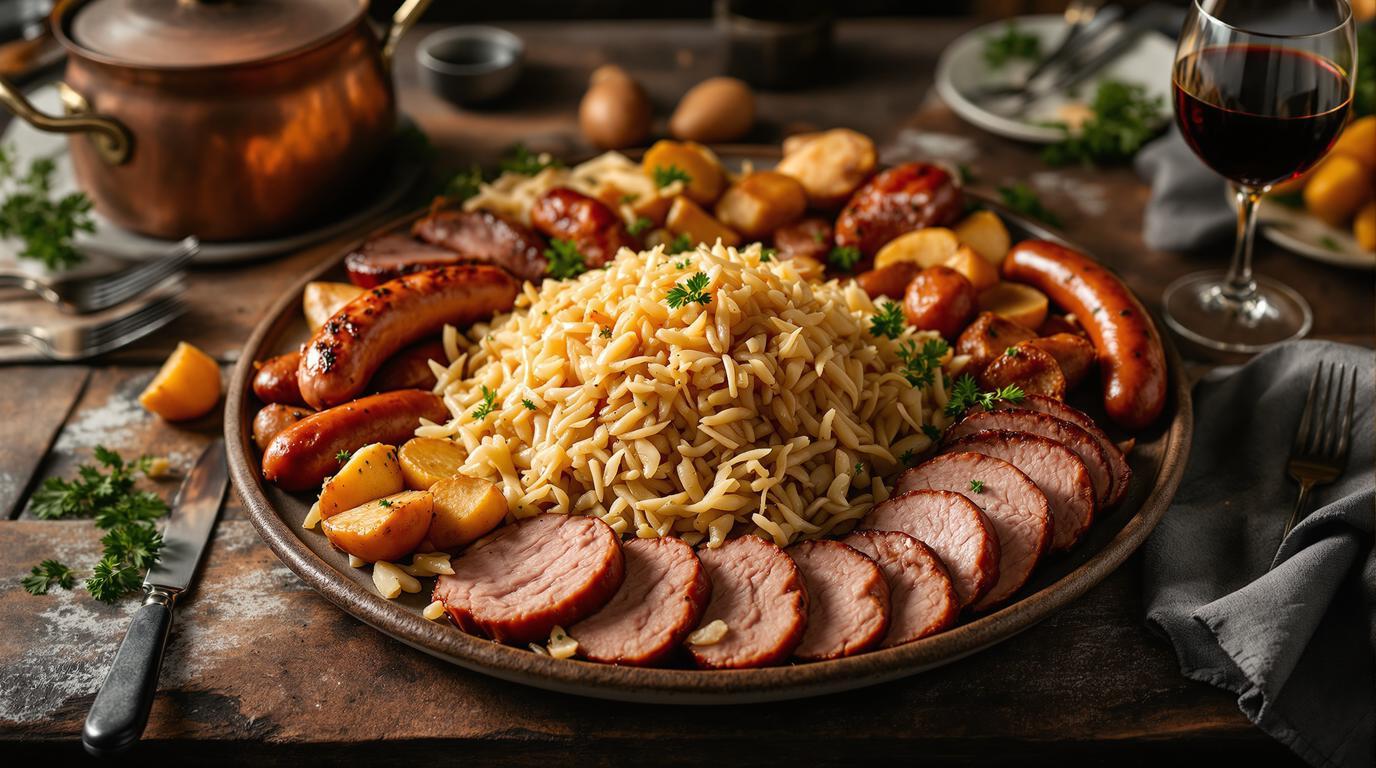The aroma of simmering choucroute garnie always takes me back to my first visit to Alsace. Standing in a timber-framed restaurant in Strasbourg, I watched in awe as the chef lifted the lid of an enormous copper pot, releasing a cloud of steam fragrant with juniper, white wine, and the unmistakable tang of fermented cabbage. What struck me most wasn’t just the symphony of aromas but the ritual-like precision with which he arranged the various meats around a golden mound of sauerkraut. This isn’t just a dish—it’s a celebration of Alsatian heritage, a beautiful marriage of French finesse and German heartiness that has graced family tables for generations.
The Story Behind Choucroute Garnie 📖
Choucroute garnie (pronounced “shoo-KROOT gar-NEE”) translates simply to “dressed sauerkraut,” but there’s nothing simple about its rich history. This iconic dish emerged from Alsace, that fascinating border region that has alternated between French and German control throughout history. The fermentation of cabbage was originally a practical preservation method for winter, but over centuries, it evolved into this magnificent feast featuring an array of smoked and cured meats nestled in tangy sauerkraut.
What many don’t realize is that there’s also a Jewish version (choucroute garnie à la juive) that substitutes kosher meats like corned beef for the traditional pork—a beautiful example of how culinary traditions adapt while preserving their essence. In my years working alongside an Alsatian chef, I learned that a proper choucroute isn’t rushed; it’s an exercise in patience and layering of flavors.
Essential Ingredients 🧾
- 3 lbs (1.4 kg) sauerkraut, preferably imported Alsatian
- 6 oz (170g) salt pork or thick-cut bacon
- 3 lbs (1.4 kg) smoked pork loin, uncooked
- 12 assorted sausages (knockwurst, kielbasa, or bratwurst)
- 6-8 medium Yukon gold potatoes
- 1 cup (240ml) dry Riesling wine
- 2 bay leaves
- 2-3 garlic cloves, minced
- 2 tsp black peppercorns
- ½ tsp caraway seeds or juniper berries (optional)
Step-by-Step Instructions 📝
- Prepare the sauerkraut: Rinse the sauerkraut briefly in cold water—just enough to temper excessive saltiness without washing away all that beautiful fermented flavor. Drain thoroughly and set aside. Many home cooks over-rinse, resulting in bland sauerkraut—a light rinse is all you need.
- Prepare the meats: Score your sausages with a shallow ¼-inch cut lengthwise. This isn’t just decorative—it allows the fat to render evenly and prevents them from bursting. If using salt pork, soak it in cold water for 30 minutes to remove excess salt.
- Create your foundation: In a large Dutch oven, sauté a thinly sliced onion in 2 tablespoons of rendered bacon fat until translucent. Add half the spices (bay leaves, pepper, and garlic). This aromatic base is crucial for developing depth.
- Layer with intention: Add half the sauerkraut, then arrange half the meats on top. Add remaining sauerkraut and meats in alternating layers. Pour the Riesling over everything. The layering technique ensures no single flavor dominates.
- Slow cook to perfection: Cover with a parchment-lined lid and bake at 325°F (160°C) for 1.5-2 hours. Meanwhile, cook the potatoes separately in salted water until tender.
- Serve family-style: On a large platter, create a bed of sauerkraut, arrange sliced meats and whole sausages around it, and garnish with boiled potatoes. Serve with Dijon mustard and rye bread.
Chef’s Note: In professional kitchens, we often prepare choucroute a day ahead and reheat it for service. The flavors meld beautifully overnight, transforming good choucroute into exceptional choucroute. If you have the time, I highly recommend this approach.
Chef’s Secret Techniques 🤫
The true secret to magnificent choucroute garnie lies in the quality of your sauerkraut and the patience in your cooking. For an authentic touch, look for imported Alsatian sauerkraut, which tends to be milder and more complex than American varieties. If that’s unavailable, a good domestic sauerkraut will work beautifully—just be judicious with your rinsing.
Many home cooks make the mistake of overcrowding their Dutch oven. If necessary, use two pots rather than cramming everything into one. Proper spacing allows the meats to cook evenly and the flavors to distribute throughout the sauerkraut. This is one lesson I learned the hard way as a young chef trying to feed a party of twenty from a single pot!
Serving & Pairing Suggestions 🍽️
In Alsace, choucroute garnie is traditionally accompanied by an off-dry Riesling or Gewürztraminer from the region. The slight sweetness balances the dish’s saltiness and acidity perfectly. For beer lovers, a crisp lager complements the hearty flavors beautifully.
For an elegant presentation, use a large, warmed platter with the sauerkraut mounded in the center and the various meats artfully arranged around it. Slice the pork loin and some sausages while leaving others whole for visual impact. Garnish with fresh parsley for color contrast against the golden sauerkraut.
I’ve served this dish at everything from casual family gatherings to sophisticated dinner parties, and it never fails to impress. There’s something about passing a platter of choucroute garnie that brings people together—perhaps it’s the shared experience of this centuries-old tradition that speaks to something deep in our collective culinary soul. Whether you’re exploring soul-warming Cajun cuisine or considering a delicate silky Italian panna cotta for dessert, this hearty Alsatian main course will beautifully anchor your meal.
Like my grandmother always said, “A well-made choucroute tells the story of a region in a single bite.” I hope this traditional recipe inspires you to create your own story and perhaps start a new tradition around your table. After all, the best dishes, like Nonna’s cloud-like gnocchi or a classic Swiss fondue, aren’t just about food—they’re about preserving our connection to the past while creating new memories for the future. For a sweet finish, consider an Earl Grey and lavender tart to balance the hearty flavors of the choucroute.
